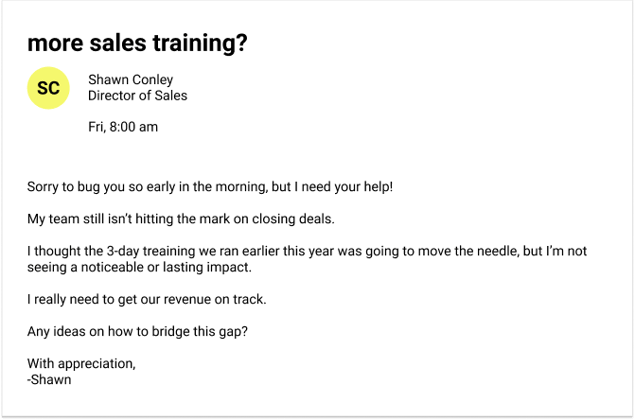L&D Moments #01
October 1, 2021
-----
L&D Moments is a weekly email series where we share a bite-sized L&D challenge (using our inbox simulation platform) and provide science-backed insights to help you navigate similar situations on the job.
-----
Welcome to L&D Moments #01!
As always, you're Director of L&D at a medium-sized B2B tech company.
It's Friday morning as you sit down at your computer with your first hot cup of coffee for the day. You log into your email and are greeted with a message from your colleague, Shawn Conley, the Director of Sales...

Click here to choose your response!
Spoiler Alert! What does the science of learning have to say about this scenario?
Does this scenario seem familiar? A common pitfall in L&D is at play: the "fire hose method!"
While multi-day seminars are great for covering a lot of information in a short amount of time, very few people are able to retain anything. Even just days after completing the training, only a few key moments will stick with participants.
A great illustration of why the human brain can't retain a lot of new information, especially when it's provided all at once, is Ebbinghaus' forgetting curve. As time passes, our ability to retain information dramatically decreases.
So how do we fix this?
The Science of Learning points us to Spaced Learning, or consuming one area of content with enough time to digest, and most importantly, apply the information. The illustration below demonstrates how spaced learning flips the forgetting curve on its head, improving retention over time.
.png?width=2629&name=Frame%201%20(3).png)
Takeaway Tip
If your employees are struggling to retain and apply concepts, try focusing content on one topic per week via microlearning—giving your team the chance to process it and apply it in a real-world setting.
Want more L&D Moments delivered straight to your inbox? Click below to subscribe!



.png?width=80&name=1-questions%20(1).png)